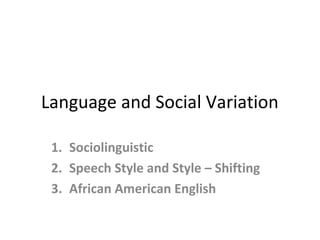
Using Technology to Facilitate K-12 Instruction
- 1. Language and Social Variation 1. Sociolinguistic 2. Speech Style and Style – Shifting 3. African American English
- 2. Language and Social Variation 1. Sociolinguistic → Social dialects, education and occupation, and social markets 2. Speech Style and Style – Shifting → Prestige, speech accommodation, register and jargon, and slang 3. African American English → Vernacular language, the sound of vernacular, and the grammar of a vernacular
- 3. Variation in Language Variation in language use among speakers or groups of speakers is a principal concern in sociolinguistics. Such variation may occur in pronunciation (acccent), word choice (lexicon), or even preferences for particular grammatical patterns.
- 4. Variation in Language Examples of the American African Vernacular English (AAVE) * Pronunciation: final pronunciation of –ing [ n ] rather than[ ŋ ] at the end of words. Ex. Sitting and drinking --- sittin’ and drinkin’ * Word Choice: She working now. Don’t include the aux. verb is in expressions to describe what is happening currently. *Grammatical patterns: the frequency negative concord (known colloquially as a double negative). Ex. He don’t know nothing, I don’t want none, or I ain’t afraid of no ghosts.
- 5. Speech Community • People who lives in the same region, but who differ in terms of education and economic status, often speak in quite different ways. • A speech community is a group of people who share a set of norms and expectations regarding the use of language.
- 6. Sociolinguistics • Definition: the study of how language is used by different groups in society. • The study of the relationship between language and society.
- 7. Sociolinguistics • Can be divided by: – Social Dialects has been mainly concerned with speakers in towns and cities. – Education and Occupation the unique circumstances of every life in each of us having and individual way of speaking, a personal dialect or idiolect, we generally tend to sound like others with whom we share similar educational backgrounds and / or occupations. – Social Markets a linguistic form that shows an effect, not just of social group, but of style or register (or other non-linguistic factors).
- 8. Social Dialects • In the social study of dialect, it is social class that is mainly used to define groups of speakers as having something in common. • Middle Class those who have more years of education and perform non-manual work. • Working Class those who have fewer years of education and perform manual work of some kind. “working –class speech,” we are talking about a social dialect. • The terms Upper and lower are used to subdivide the groups, mainly on an economic basis, making “upper-middle class speech” another type of social dialect or sociolect.
- 9. Education and Occupation • Those who leave the educational system at an early age, there is a general pattern of using certain forms that are relatively infrequent in speech. Ex. Them boys throwed somethin’ or It wasn’t us what done it. • Those who spend more time in the educational system tent to have more features in their spoken language that derive from a lot of time spent with the written language, so that threw is more likely than throwed and who occurs more often that what in reference to people.
- 10. Education and Occupation • Social variables: As adults, the outcome of our time in the educational • system is usually reflected in our occupation and socio-economic status. The way bank executives, as opposed to window cleaners, talk to each other usually provide linguistic evidence for the significance of these social variables. • William Labov combined elements from place of occupation and socioeconomic status by looking at pronunciation differences among salespeople in three different stores in New York. He focused in the postvocalic /r/, that is, the /r/ sound after a vowel and before a consonant or at the end of a word. • Results: The higher the socio-economic status of the store, the more /r/ sounds were produced, and the lower the status, the fewer /r/ sound were produced by those who work there. So, the frequency of occurrence of this linguistic variable (r) could mark the speech samples as upper middle class versus middle class versus working class.
- 11. Social Markets • Pronunciations features that function as social markers – Final pronunciation of –ing with [ n ] rather than[ ŋ ] at the end of words. Ex. Sitting and drinking --- sittin’ and drinkin’ (indication of lower class and less education). – The [ h ] –dropping which make the words at and hat sound the same. It occurs at the beginning of words and can result in utterances that sound like I’m so ‘ungry I could eat an ‘orse. (associated with lower class and less education)
- 12. Language and Social Variation Summary Sociolinguistics The study of the relationship between language and society. • Social Dialects. It is social class that is mainly used to define groups of speakers as having something in common. • Education and Occupation. Those who spend more time in the educational system tent to have more features in their language and have a better job. • Social Markets. Speech sound features. That is, having this feature occur frequently in your speech (or not) marks you as member of particular social group, whether you realized or not.
Hinweis der Redaktion
- That